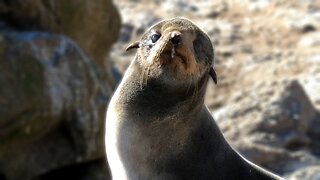Premium Only Content

Wild Maned Wolf roar-barking
The Maned Wolf (Chrysocyon brachyurus), as the name suggests, has a mane on the back of its neck, but unlike its name suggests, it's actually not a wolf. It's called a wolf because of its size (about 90cm/3ft at shoulder height); some people like to refer to it as a "fox on stilts", but although it does resemble a fox, it's not a fox either. In fact, the maned wolf is the sole extant member of the Chrysocyon genus, meaning that it has no actual close relatives. Its closest living relative is the Bush Dog (Speothos venaticus), a short-legged canid with a round head that looks more like a bear than a maned wolf.
The scientific name Chrysocyon brachyurus is of Greek origin, meaning short-tailed golden dog.
Unlike true wolves, maned wolves do not howl, they roar-bark, as it can be seen in this video. Although they are solitary animals, they do that to communicate with other maned wolves, be it with their pups, a partner, or to mark their territory.
Another difference between true wolves and maned wolves is that true wolves are carnivores, whereas maned wolves are omnivores, which means that they eat a little bit of everything (mammals, birds, reptiles, eggs, insects), but their diet is mostly plant-based. They eat many different fruits that they can find in their environment, but since they're not available year-round, depending on the time of year, their diet might become a bit more animal-based. Their favorite food though IS available year-round, making it the very base of they're diet; so much so that it was named after it: the wolf apple.
The maned wolf is the largest canid in South America and can be found in Brazil, Bolivia, Paraguay, and Argentina. It used to occur in Uruguay as well, but it hasn't been seen there since 1990. Most of its range is in Brazil, especially in the Cerrado, the Brazilian Savannah. In fact, the maned wolf occurs in 90% of the Cerrado, which shows how connected the species and the biome are.
The maned wolf was last assessed by the IUCN Red List of Threatened Species in 2015 and classified as Near Threatened, with an estimated 17,000 mature individuals left in the wild, but it said that "if deforestation reaches the maximum estimated rate of loss (2% per year), then simulation suggests a national population reduction of 56% at the end of 100 years", not to mention that is also subject to other threats, such as road kills and diseases from domestic dogs. They concluded it with "The species’ situation is considered to be of major concern due to the various threats acting throughout its entire range and should be regularly re-evaluated."
The beautiful male in the video is wearing a GPS/VHF tracking collar and is monitored by Onçafari, at Trinjunção Lodge, at the heart of the Cerrado. The Onçafari Association was established to promote the conservation of the environment and to contribute to the socioeconomic development of the regions in which it operates, through ecotourism and scientific studies, and works to preserve biodiversity within several Brazilian biomes, with emphasis on jaguars and maned wolves.
If you would like to stay at the Trijunção Lodge, you could go on a safari to try and find these amazing animals. It is truly an amazing experience!
-
 0:35
0:35
NataliaCara
2 years agoAdorable young Northern Fur Seal is curious about researchers
269 -
 29:54
29:54
Michael Franzese
7 hours agoCan Trump accomplish everything he promised? Piers Morgan Article Breakdown
56.3K43 -
 2:08:19
2:08:19
Tactical Advisor
11 hours agoThe Vault Room Podcast 006 | Farwell 2024 New Plans for 2025
142K11 -
 34:12
34:12
inspirePlay
1 day ago $4.45 earned🏆 The Grid Championship 2024 – Cass Meyer vs. Kelly Rudney | Epic Battle for Long Drive Glory!
53.1K8 -
 17:50
17:50
BlackDiamondGunsandGear
8 hours ago $0.96 earnedTeach Me How to Build an AR-15
31K4 -
 9:11
9:11
Space Ice
23 hours agoFatman - Greatest Santa Claus Fighting Hitmen Movie Of Mel Gibson's Career - Best Movie Ever
94.5K42 -
 42:38
42:38
Brewzle
1 day agoI Spent Too Much Money Bourbon Hunting In Kentucky
61.5K12 -
 1:15:30
1:15:30
World Nomac
17 hours agoMY FIRST DAY BACK in Manila Philippines 🇵🇭
46.5K9 -
 13:19
13:19
Dr David Jockers
1 day ago $9.81 earned5 Dangerous Food Ingredients That Drive Inflammation
67.5K17 -
 1:05:13
1:05:13
FamilyFriendlyGaming
1 day ago $15.47 earnedCat Quest III Episode 8
123K3